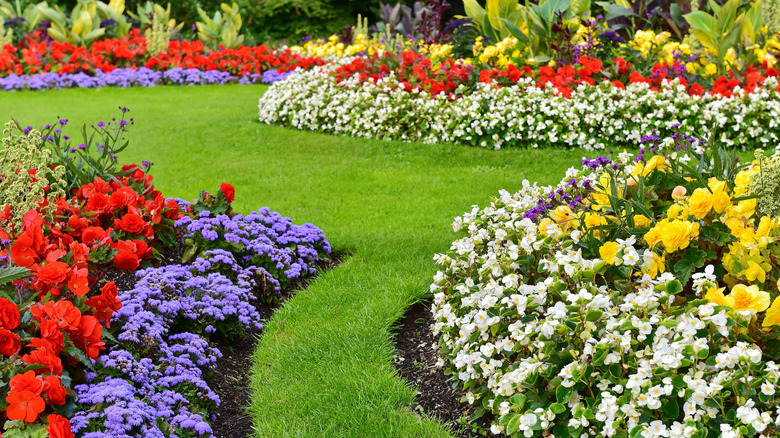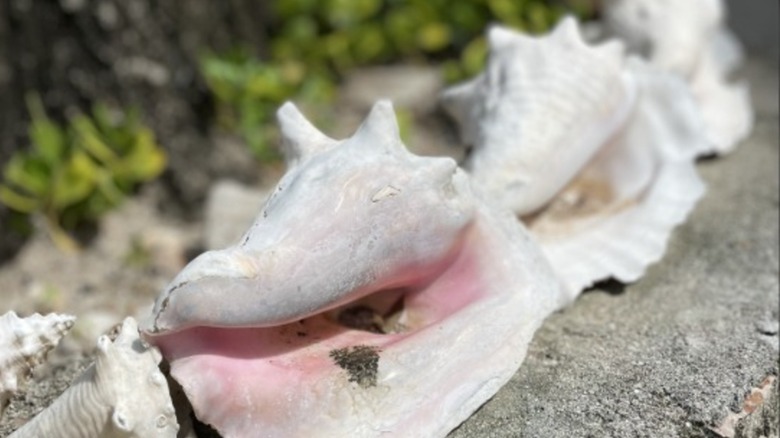12 Natural Landscape Edging Ideas To Elevate Your Yard
We may receive a commission on purchases made from links.
Considering giving your yard a little clean-up? Why not add a nice finishing touch with a crisp, clean border edge? Not only will it help define the space of your yard, but there are so many materials available now that you're sure to find one that matches your aesthetics and enthusiasm level for maintenance. We recommend skipping the ho-hum plastic borders and opting for a natural alternative border edge, instead. That way, you'll be able to repurpose things you might already have lying around, letting you put that part of your landscaping budget towards something more exciting, like plants. Plus, natural edging just gives yards a classic look, don't you think?
That's why we've rounded up a dozen of our favorite creative DIYs landscapers have used to create spectacular yards. Whether you're a beach bum, cottagecore enthusiast, or just need something that will work in a drought-friendly yard, you're sure to find a project here that can inspire you. So break out the graph paper and a pen, because we're about to create the landscape of your dreams.
Go for the minimalist look by just cutting the turf
Using just a turf line is a fantastic option, because it's a minimalist look, requires little upkeep, and can always be added onto later. You can use a hand tool like this Colwelt Manual Lawn Edger to create that crisp line, but if you've got a bigger space to cut, get something a little more substantial, like the WORX WG896 12 Amp Lawn Edger and Trencher. Just give your local 811 a call before you dig; it's always better to be safe than sorry.
River rocks and cobblestones are popular edging materials
Natural stone edging works great because it requires fewer materials — just big, bulky stones. The downside, of course, is that the stones are super heavy, so you'll need to plan your layout ahead of time and may need to source a way to get the stones to your yard. Local quarries may be useful, but don't discount your local garden center or nursery, too, especially if they offer bulk landscaping materials. Many will deliver for a small fee, making it easy for those without a pickup truck. Call ahead to ask about pricing and size range of the stones, so you can plan accordingly.
Use sweetpotato vine for those weird gaps between fences and walkways
Sweetpotato vine is different from the version of sweet potato plant that grows the actual vegetable — though you can give either a try if you're feeling adventurous. We love this idea for using sweetpotato vine, though, because it's a fast grower that can fill in those weird gaps that are often taken over by weeds. Plus, it comes in a variety of colors. We're pretty partial to the 'Midnight' blackish-purplish types, because we're nerds for unusually-colored plants, but this TikTok showing a bright lime variety looks fabulous, too.
Limestone always gives a classic look to landscapes
If you want something that meets in the middle of "natural material" and "clean lines," then opt for limestone blocks. Limestone has excellent thermal resistance, making it a safe and cool surface for playful kiddos or pets even in the hot summer sun. The bricks come in a variety of sizes, so you can mix and match to fit your yard's dimensions. Plus, you can either lay them flat or turn them on their side and drive them into the ground with a rubber mallet to give your edge a taller lip.
Use flagstones for places where thicker edging is needed
If you want a wide border that's low maintenance, consider using flagstones. Flagstones have a more organic shape than limestone blocks, making them perfect for places where straight lines aren't possible — or wanted. Plus, they come in a variety of colors and sizes so they can really fit any decor style, stack easily, and are pretty cheap; just make sure to pick ones without sharp edges or arrange them so that the edges can't get nicked by your lawnmower or weed whacker.
Timber lasts for years and can be cut to whatever length your border needs
If you're concerned about keeping the grass that's hitting your edging clean, timber is perfect. Not only will it give you clean lines, but it's durable and thick enough that even one beam can keep a thick layer of mulch from escaping. There are a few wood options to choose from: Redwood, cedar, and pressure-treated pine all work well and weather very nicely. Skip the old railroad ties, though. While they give a nice, rustic look, they're often treated with chemicals that are toxic to plants.
Fallen branches make easy (and free) landscape edges
Had a bad wind storm that knocked a few branches off your trees? Congratulations, you've now got free landscape edging! Fallen branches and tree limbs are super durable options that have a cool, organic look to them, and aren't limited to whatever timber is in stock at your local home improvement store. Keep the bark on if you can so that the branches have protection from the weather. If you've got more branches than your edging demands, you can use them as home decor or turn them into unique plant stands.
Create a unique edging by weaving thinner branches into a small fence
Weaving long, thin branches into a short edging fence is a great way to repurpose leftover pieces from bigger tree limbs and you can add onto them as you go. Pop a few thicker branches into a ground as posts in any shape you like; branch fences can be made into sharp lines, softer curves, or border circles around trees. But, if you're not into the barren limb look, these woven fences also look great with a creeping ground cover, like sweetpotato vine or creeping phlox.
Low-growing plants or ground covers make a natural edging that's perfect for corners or more organically-shaped beds
Speaking of plants, another brilliant landscape edge is low-growing or mounding plants. Using plants as a natural material to define your landscape borders gives you a full spectrum of colors that other materials just don't have — all while making local pollinators super happy. Plus, they can help soften sharp edges and give your pathways a more organic flow. There are ground covers that love shade, ground covers for flower beds, and those for whatever else you need; the only limit is your imagination — and budget.
Dwarf ornamental grasses creates edging that's low maintenance
Maybe you're not into the colorful ground cover idea, but the thought of low-maintenance plants is still enticing. If so, you're in luck, because ornamental grasses are the best of both worlds. Not only are they able to create the soft edges of a flowering ground cover, but they're easy to care for and come in a variety of styles. Opt for low-growing grasses, like creeping sedge (Carex laxiculmis), Japanese forest grass (Hakonechloa macra), or Japanese sedge (Carex morrowii).
Plant rows of succulents for drought-friendly edging
If you love the idea of using plants as a border, but live in a desert climate, opt for rows of succulents. Succulents store water in their thick, fleshy leaves, so they are great for drought-prone landscapes and can add serious curb appeal to your yard. We love the idea of using different types to create patterns and swirls, turning a ho-hum landscape into something truly dynamic. Spread pumice around your border once planted, because it's the perfect soil additive for succulents, thanks to its double-duty ability to retain moisture and improve drainage.
Use large seashells or conches for a coastal look
If you're near a coastline or just love to give your home a beachy vibe, put large seashells or conches around your yard's edge for a cool, oceanic border. Saving seashells for decor or landscaping purposes will require a quick muriatic acid wash first, such as with Klean-Strip Great Muriatic Acid) to prevent discoloration or a lingering briny smell, but it's not as hardcore as it sounds and will preserve your shell collection for years to come. You can also use crushed shells as a gravel-style border if big shells are hard to come by.

